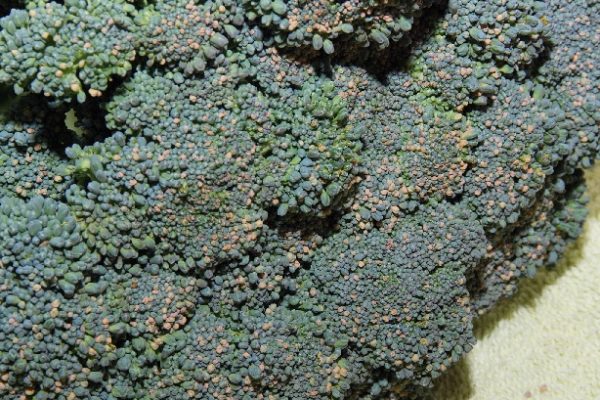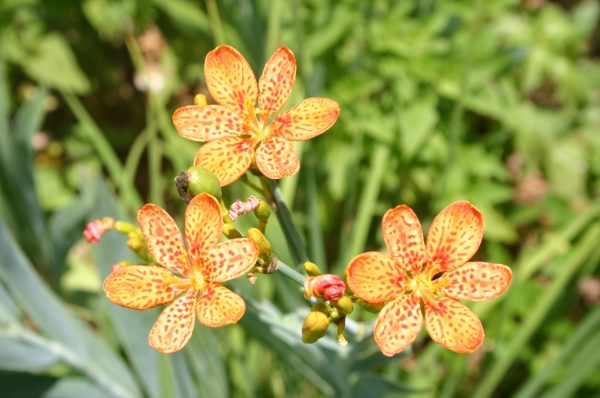Broccoli

Brassica oleracea var. botrytis
Broccoli is a member of the mustard family, and grows along the seacoasts of Europe from Denmark to France, and in other locations from Greece to Great Britain.
• More detailed information can be found in The Georgia Fruit & Vegetable Book by Walter Reeves and Felder Rushing
• See also:
Although it has been cultivated for 5,000 years, broccoli was developed from other cole crops as a specific crop quite late and has been popular in this country only since the 1930s. This vegetable, grown for its compact cluster of flower buds or head, is picked before the flower buds begin to open. Secondary heads that develop in the leaf axils (between the bases of the leaves and the stem) can be harvested for several weeks after the central head is cut.
WHEN TO PLANT
This cool-weather crop can stand a freeze. For best results, plant broccoli early and harvest it before hot weather arrives. Sow seed directly in the garden as early as the soil can be worked. For the earliest production, however, start with transplants. Sow seed indoors about 8 weeks before the frost-free date (average date of last frost), and grow the plants under lights or in the greenhouse. Transplant them into the garden about 3 weeks before the frost-free date. Transplants are usually available from garden centers about that time as well. If you choose not to grow your own, make sure that the plants you buy have a good green color, are short and compact, and have no pests on them. A reliable local outlet is the safest source for quality plants. Since the broccoli will be harvested and out of the garden by midsummer, plan to replace it with a second crop. For a fall crop, sow seeds indoors about July 1, then set the seedlings in the garden about August 10. In mild fall weather broccoli may last until Thanksgiving – or even later, depending on how late you plant and when the first freeze of fall comes.
WHERE TO PLANT
Broccoli prefers full sun (8 to 10 hours will suffice), in a well-drained soil. It will produce well in partial shade (filtered sun all day or shade part of the day), but leaves will be larger and the heads will be smaller.
HOW TO PLANT
Apply a complete garden fertilizer, such as 10-10-10, at a rate of 1 1/2 pounds per 100 square feet of garden. Spade or rototill the garden. (See “Soil Preparation” in the introduction to the vegetable garden.) In rows, space the transplants about 18 inches apart, with 36 inches between rows. In a bed, space the plants 16 to 18 inches apart, which will allow 2 or 3 plants across a 48-inch bed. Set the plants at the same depth they were growing. If root maggots have been a problem in the past and your previous crops have suffered damage, mix an approved insecticide with water according to the label directions, and use it as a drench as transplants are watered in.
CARE AND MAINTENANCE
Broccoli requires very little care to produce a crop. For the best-quality broccoli, water as necessary to keep the plants vigorous and growing; they need about 1 inch of water per week. Hardened-off plants (those that have been stunted by poor care) will often develop buttons which are useless, tiny heads on the seedling plants. Side-dress them with a complete fertilizer when the plants are about half grown, 10 to 12 inches tall. Pests and diseases may pose a problem. Prevent infestation of cabbage worms with a “biological worm control” spray or dust (available at most garden centers). Avoid root and stem diseases by rotating plantings of broccoli and other “cole crops” such as Brussels sprouts, cabbage, and collards, in another part of the garden.
ADDITIONAL INFORMATION
Harvest the heads with a sharp knife, leaving about 6 inches of stem attached, while they are still compact and before any of the flower buds open. Allow side shoots to develop for continuous production. Eventually, the size of the lateral shoots decreases, and they are not worth harvesting. Flowers on broccoli heads continue to develop after they are picked, so keep them in the refrigerator and use them as soon as possible because they are unusable after the flowers start to open (they are poor looking and poor tasting, and they have poor texture).
VARIETIES
Variety Name
Days to Maturity
Comments
HYBRIDS
Arcardia
65
Fall
Cruiser
58
Drought tolerant
Green Comet
55
Early producing, heat tolerant, good spring or fall, AAS
Green Goliath
55
12-inch heads
Packman
55
Summer or fall
Premium Crop
65
Good extended harvest
NOVELTY
Purple Sprouting
85
Very tender purple heads
Romanesque
75
Spiraling chartreuse heads
OPEN POLLINATED
Waltham 29
75
Best for fall production













